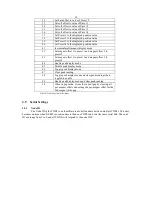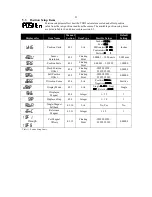
13
4.3.5
SSI Error Value and Error Mask
SSI sensors from different manufacturers can have different ways of indicating an error condition
(usually a “no magnet” error). Because only one type of data (the position) can be returned from a SSI
sensors, the sensor indicates an error by varying some aspect of the position data it returns.
The SSI Error Value and Error Mask combine to provide versatile SSI error condition detection.
The raw position data retrieved from the sensor is bit-wise ANDed with the SSI Error Mask and compared
to the SSI Error Value. If the masked position is equal to the Error Value, a missing magnet condition is
reported (see section 3.2.1). Only least-significant bits of the SSI Error Value are used for this comparison.
The number of bits defined by the SSI Word Length (section 4.3.4) are compared to the SSI Error Value;
the remaining bits of the SSI Error Value are ignored.
Examples:
The most common value for SSI sensors to output in the event of an error is 0. To detect this value,
the error output mask is set to FFFFFFFFh, and the error output is set to 00000000h. This setting will report
an error only when a position of 0 is returned from the sensor. This is the default setting for the SSI Error
Value and Error Mask.
Another common error condition output is to set a certain bit of the position output active when an
error occurs. If a sensor sets bit 21 (the 22
nd
bit) active when an error occurs, both the error output mask and
the error output value are set to 00200000h. This setting will report an error anytime bit 21 is active,
regardless of the state of the other data bits.
4.3.6
Gradient
When using a PWM or Start/Stop transducer, the gradient must be programmed into the TDD. The
gradient is a measurement of the speed of the sonic pulse within the transducer waveguide and is printed on
the can of the transducer. Failure to enter this value will cause incorrect position display.
4.3.7
Start/Stop Holdoff Period
A Start/Stop transducer returns one pulse per magnet installed on the transducer. The minimum
time that must elapse before the first pulse is received can be configured. If you are working with a non-
standard null and are seeing a “No Magnet” error when the magnet is moved close to the head of the
transducer, lower this value. The default holdoff period is 20ms.
4.3.8
CANbus Baud Rate
The CANbus interface can be configured to operate at 125, 250, 500 or 1000 kb/s. The default
baud rate is 500kbps.
4.3.9
CANbus Transducer Serial Number
A CANbus transducer’s serial number is used to identify the transducer. This number must be
entered before a CANbus transducer can be communicated with.
4.3.10 Plausibility Filtering
Plausibility filtering will detect values far outside the normal range of valid positions and hide them.
This allows the TDD2 to display stable positions from sensors that occasionally return bad data. A setting
of zero will disable plausibility filtering. For values greater than zero, a position is considered invalid if it is
more than 100 times the setting different than the previous reading. For example, a setting of 100 will cause
readings more than 10,000 counts different than the previous reading to be considered invalid. The default
plausibility filter level is 50.
4.3.11 SSI Shift Right (
TNSDCR
→
SSISHR
)
The output data word can be shifted right before it is used. This can be used to isolate the sensor
data if the least significant bits of the SSI data word are flags or other undesired information. By default the
data word is shifted by 0 bits (no shifting occurs). Shifting right by
n
bits is equivalent to dividing the data
word by 2
n
and truncating the result to be an integer.






























